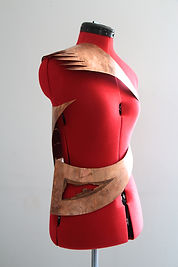EMMA MACEY
ARTIST | TEACHER
Notes on Object Agency
I find the anthropological definition of object agency problematically disconnected. Westgate says that ‘object agency is about the reflected agency that a person gives to a thing. As a lens through which to view (objects), it allows us to reflect on the meaning that an object had to a person or group in the past’ (Westgate, 2015). And therein lies the problem; object agency is a term used primarily to discuss objects from the past that once belonged to others and so the ‘meaning’ that Westgate refers to is imposed; it is didactic.
If an object truly has agency and its actions can affect the possessor, then the context in which the object was originally made and used is important. When an object is removed from its intended context and placed in the hands of academics, I would argue that its agency dilutes as ‘things were not things in themselves but they are what they are by virtue of relations to everything else’ (Russell, 2007). Hegel’s (1770-1831) philosophy mourned the loss of the spirit of artefacts and objects in our museums and cultural discourses (Russell, 2007):
The statues are now only stones from which the living soul has flown... the works of the Muse now lack the power of the Spirit, for the Spirit has gained its certainty of itself from the crushing of gods and men. (Hegel, 1977 (1832)).
This is why Baudrillard’s words resonate. He says that ‘While artefacts, images and landscape may each have social biographies and therefore seem to express independent agency, it is the human assignment of meaning rather than any agency within them that leads to this perception’ (Baudrillard, 1996 (1st Ed. 1968), p. 348).
This is a significant distinction for artists and craftspeople that manufacture rather than inherit objects. Inherited objects hold a narrative, an orientation, an history that gives them agency. Consider a woman receiving a diamond ring: it could be given to her as an engagement present, she could have bought it with the proceeds of a successful business venture, it could have been passed down to her after the death of a loved one, it could be given to her after the birth of a child. The person who gave the woman the ring and time when it was received will all be recalled when the woman looks at the ring on her finger. The context directs the agency of the object.
A craftsperson manufacturing an object cannot usually manufacture the context in which the object will be received or used and so it could be argued that they have limited control over the agency of the object. However, the artist’s treatment of texture, material, form and so forth are instrumental in guiding sensory responses that in turn affect actions; in other words, the object has the capacity to act in a way that affects the possessor and so it has agency. For example, when I wear the suit of armour that I made for the Rites of Passage Project, the heaviness of the metal on my chest alters my breathing, the rear-weighted balance pulls my shoulders back so I stand tall and the sharp edges prompt me to move carefully. Would this suit of armour have a stronger agency if I had inherited it? In this instance, I think not; making the object was a form of catharsis, a compulsive response to a personal trauma. The agency of the object would be fundamentally different if the object was inherited, as the power would be in the inherited narrative rather than in the way that the formal qualities prompted responses that recalled specific personal events. As Russell notes:
Throughout the evidential discourse of human thought, people have grappled with existence and formulated different strategies to resolve their experiences of ontic crises in negotiating lifeworlds...some psychoanalysts have utilised strategies such as internal object relations…in therapeutic treatments for individuals seeking to orient themselves in the modern world. (Russell, 2007)
This is a phenomena that must be considered in the study of archaeology; the motivation behind the decisions made by the craftsperson who created the object are as significant as the function of the object; in other words, the context in which the artefact was made is as significant to a discussion about object agency as the context in which the artefact was used.
References
Baudrillard, J. (1996 (1st Ed. 1968)). The System of Objects. (J. Benedict, Trans.) London: Verso.
Hegel, G. (1977 (1832)). Aesthetics: Lectures on Fine Arts. (A.V.Miller, Trans.) Oxford: Oxford University Press.
Kollectiv, P. a. Can Objects Perform?: Agency and Thingliness in Contemporary Sculpture and Installation. Sculpture and Performance Conference. England: Henry Moore Institute.
MacGregor, N. (2012). The History of the World in 100 Objects. London: Penguin.
Russell, I. (2007). Objects and Agency: Some Obstacles and Opportunities of Modernity’. (V. &. J.Thomas, Ed.) Journal of Iberian Archeology , 9/10.
Westgate, A. (2015, April 1). A Note on Object Agency. Retrieved August 17, 2015, from The Object Agency: https://theobjectagency.wordpress.com/2015/04/01/a-note-on-object-agency/#more-542
